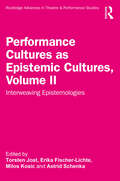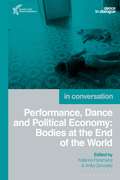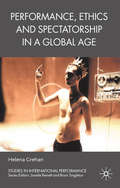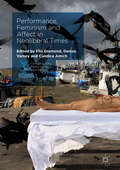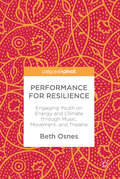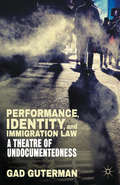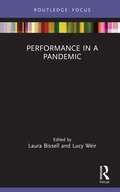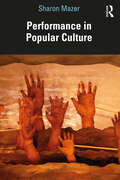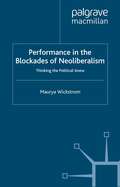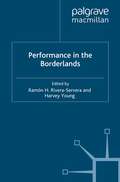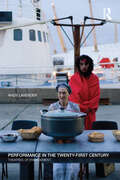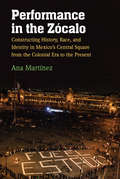- Table View
- List View
Performance Cultures as Epistemic Cultures, Volume II: Interweaving Epistemologies (Routledge Advances in Theatre & Performance Studies)
by Torsten Jost, Erika Fischer-Lichte, Milos Kosic and Astrid SchenkaThis volume investigates performance cultures as rich and dynamic environments of knowledge practice through which distinctive epistemologies are continuously (re)generated, cultivated and celebrated. Epistemologies are dynamic formations of rules, tools and procedures not only for understanding but also for doing knowledges. This volume deals in particular with epistemological challenges posed by practices and processes of interweaving performance cultures. These challenges arise in artistic and academic contexts because of hierarchies between epistemologies. European colonialism worked determinedly, violently and often with devastating effects on instituting and sustaining a hegemony of modern Euro-American rules of knowing in many parts of the world. Therefore, Interweaving Epistemologies critically interrogates the (im)possibilities of interweaving epistemologies in artistic and academic contexts today. Writing from diverse geographical locations and knowledge cultures, the book’s contributors—philosophers and political scientists as well as practitioners and scholars of theater, performance and dance—investigate prevailing forms of epistemic ignorance and violence. They introduce key concepts and theories that enable critique of unequal power relations between epistemologies. Moreover, contributions explore historical cases of interweaving epistemologies and examine innovative present-day methods of working across and through epistemological divides in nonhegemonic, sustainable, creative and critical ways. Ideal for practitioners, students and researchers of theater, performance and dance, Interweaving Epistemologies emphasizes the urgent need to acknowledge, study and promote epistemological plurality and diversity in practices of performance-making as well as in scholarship on theater and performance around the globe today.
Performance Cultures as Epistemic Cultures, Volume II: Interweaving Epistemologies (Routledge Advances in Theatre & Performance Studies)
This volume investigates performance cultures as rich and dynamic environments of knowledge practice through which distinctive epistemologies are continuously (re)generated, cultivated and celebrated. Epistemologies are dynamic formations of rules, tools and procedures not only for understanding but also for doing knowledges. This volume deals in particular with epistemological challenges posed by practices and processes of interweaving performance cultures. These challenges arise in artistic and academic contexts because of hierarchies between epistemologies. European colonialism worked determinedly, violently and often with devastating effects on instituting and sustaining a hegemony of modern Euro-American rules of knowing in many parts of the world. Therefore, Interweaving Epistemologies critically interrogates the (im)possibilities of interweaving epistemologies in artistic and academic contexts today. Writing from diverse geographical locations and knowledge cultures, the book’s contributors—philosophers and political scientists as well as practitioners and scholars of theater, performance and dance—investigate prevailing forms of epistemic ignorance and violence. They introduce key concepts and theories that enable critique of unequal power relations between epistemologies. Moreover, contributions explore historical cases of interweaving epistemologies and examine innovative present-day methods of working across and through epistemological divides in nonhegemonic, sustainable, creative and critical ways. Ideal for practitioners, students and researchers of theater, performance and dance, Interweaving Epistemologies emphasizes the urgent need to acknowledge, study and promote epistemological plurality and diversity in practices of performance-making as well as in scholarship on theater and performance around the globe today.
Performance, Dance and Political Economy: Bodies at the End of the World (Dance in Dialogue)
by Katerina Paramana and Anita GonzalezThis book examines the relation between bodies and political economies at micro and macro levels. It stands in the space between ends and beginnings – some long-desired, such as the end of capitalism and racism, and others long-dreaded, such as the climate catastrophe – and reimagines what the world can be like instead. It offers an original investigation into the relation between performance, dance, and political economy, looking at the points where politics, economics, ethics, and culture intersect. Arising from live conversations and exchanges among the contributors, this book is written in an interdisciplinary and dialogical manner by leading scholars and artists in the fields of Performance Studies, Dance, Political Theory, Economics, and Social Theory: Marc Arthur, Melissa Blanco Borelli, Anita Gonzalez, Alexandrina Hemsley, Jamila Johnson-Small, Elena Loizidou, Tavia Nyong'o, Katerina Paramana, Nina Power, and Usva Seregina. Their critical and creative examinations of the relation between bodies and political economy offer insights for both imagining and materializing a world beyond the present.
Performance, Dance and Political Economy: Bodies at the End of the World (Dance in Dialogue)
This book examines the relation between bodies and political economies at micro and macro levels. It stands in the space between ends and beginnings – some long-desired, such as the end of capitalism and racism, and others long-dreaded, such as the climate catastrophe – and reimagines what the world can be like instead. It offers an original investigation into the relation between performance, dance, and political economy, looking at the points where politics, economics, ethics, and culture intersect. Arising from live conversations and exchanges among the contributors, this book is written in an interdisciplinary and dialogical manner by leading scholars and artists in the fields of Performance Studies, Dance, Political Theory, Economics, and Social Theory: Marc Arthur, Melissa Blanco Borelli, Anita Gonzalez, Alexandrina Hemsley, Jamila Johnson-Small, Elena Loizidou, Tavia Nyong'o, Katerina Paramana, Nina Power, and Usva Seregina. Their critical and creative examinations of the relation between bodies and political economy offer insights for both imagining and materializing a world beyond the present.
Performance Drawing: New Practices since 1945 (Drawing In)
by Maryclare Foá Jane Grisewood Birgitta Hosea Carali McCallWhat is 'performance drawing'? When does a drawing turn into a performance? Is the act of drawing in itself a performative process, whether a viewer is present or not? Through conversation, interviews and essays, the authors illuminate these questions, and what it might mean to perform, and what it might mean to draw, in a diverse and expressive contemporary practice since 1945. The term 'performance drawing' first appeared in the subtitle of Catherine de Zegher's Drawing Papers 20: Performance Drawings, in particular with reference to Alison Knowles and Elena del Rivero. In this book, it is used as a trope, and a thread of thinking, to describe a process dedicated to broadening the field of drawing through resourceful practices and cross-disciplinary influence. Featuring a wide range of international artists, this book presents pioneering practitioners, alongside current and emerging artists. The combination of experiences and disciplines in the expanded field has established a vibrant art movement that has been progressively burgeoning in the last few years. The Introduction contextualises the background and identifies contemporary approaches to performance drawing. As a way to embrace the different voices and various lenses in producing this book, the authors combine individual perspectives and critical methodology in the five chapters. While embedded in ephemerality and immediacy, the themes encompass body and energy, time and motion, light and space, imagined and observed, demonstrating how drawing can act as a performative tool. The dynamic interaction leads to a collective understanding of the term, performance drawing, and addresses the key developments and future directions of this applied drawing process.
Performance Drawing: New Practices since 1945 (Drawing In)
by Maryclare Foá Jane Grisewood Birgitta Hosea Carali McCallWhat is 'performance drawing'? When does a drawing turn into a performance? Is the act of drawing in itself a performative process, whether a viewer is present or not? Through conversation, interviews and essays, the authors illuminate these questions, and what it might mean to perform, and what it might mean to draw, in a diverse and expressive contemporary practice since 1945. The term 'performance drawing' first appeared in the subtitle of Catherine de Zegher's Drawing Papers 20: Performance Drawings, in particular with reference to Alison Knowles and Elena del Rivero. In this book, it is used as a trope, and a thread of thinking, to describe a process dedicated to broadening the field of drawing through resourceful practices and cross-disciplinary influence. Featuring a wide range of international artists, this book presents pioneering practitioners, alongside current and emerging artists. The combination of experiences and disciplines in the expanded field has established a vibrant art movement that has been progressively burgeoning in the last few years. The Introduction contextualises the background and identifies contemporary approaches to performance drawing. As a way to embrace the different voices and various lenses in producing this book, the authors combine individual perspectives and critical methodology in the five chapters. While embedded in ephemerality and immediacy, the themes encompass body and energy, time and motion, light and space, imagined and observed, demonstrating how drawing can act as a performative tool. The dynamic interaction leads to a collective understanding of the term, performance drawing, and addresses the key developments and future directions of this applied drawing process.
Performance, Ethics and Spectatorship in a Global Age (Studies in International Performance)
by H. GrehanThis book takes performance studies in exciting new directions, exploring the ways in which ethics can be used to understand the complex questions facing contemporary spectators. Engaging with five key performances, the book reflects on the emotional and intellectual impacts of politically inflected performance on spectators, critics and theorists.
Performance, Exile and ‘America’ (Studies in International Performance)
by S. Jestrovic Y. MeerzonThis collection investigates dramatic and performative renderings of 'America' as an exilic place particularly focusing on issues of language, space and identity. It looks at ways in which immigrants and outsiders are embodied in American theatre practice and explores ways in which 'America' is staged and dramatized by immigrants and foreigners.
Performance, Feminism and Affect in Neoliberal Times (Contemporary Performance InterActions)
by Elin Diamond Denise Varney Candice AmichThis book is a provocative new study of global feminist activism that opposes neoliberal regimes across several sites including Asia, Australia, Canada, Europe, Latin America and the United States. The feminist performative acts featured in the book contest the aggressive unravelling of collectively won gains in gender, sexual and racial equality, the appearance of new planes of discrimination, and the social consequences of political economies based on free market ideology. The investigations of affect theory follow the circulation of intensities – of political impingements on bodies, subjective and symbolic violence, and the shock of dispossession – within and beyond individuals to the social and political sphere. Affect is a helpful matrix for discussing the volatile interactivity between performer and spectator, whether live or technologically mediated. Contending that there is no activism without affect, the collection brings back to the table the activist and hopeful potential of feminism.
Performance for Resilience: Engaging Youth on Energy and Climate through Music, Movement, and Theatre
by Beth OsnesThis book focuses on Shine, a musical performance about how energy, humanity, and climate are interrelated. Weaving together climate science and artistic expression, it results in a funny and powerful story spanning 300 million years. The first half is professionally scripted, composed, and choreographed to convey how our use of fossil fuels is impacting our climate. The second half - our future story - is authored by local youth to generate solutions for their city’s resilience. In rehearsing the musical, participants themselves embody aspects of climate science and human development. Ultimately, it demonstrates that performance can be a dynamic tool for youth to contribute to their community’s resilience. Educators can use this book to guide youth in creative expression based on (or inspired by) Shine. Included are the script, links to the music and video of the performance, materials for building curricula, interviews with collaborators, and lessons learned along Shine’s year-long international tour.
Performance, Identity, and Immigration Law: A Theatre of Undocumentedness
by G. GutermanHow has contemporary American theatre presented so-called undocumented immigrants? Placing theatre artists and their work within a context of on-going debate, Guterman shows how theatre fills an essential role in a critical conversation by exploring the powerful ways in which legal labels affect and change us.
Performance in a Militarized Culture
by Sara Brady Lindsey MantoanThe long cultural moment that arose in the wake of 9/11 and the conflict in the Middle East has fostered a global wave of surveillance and counterinsurgency. Performance in a Militarized Culture explores the ways in which we experience this new status quo. Addressing the most commonplace of everyday interactions, from mobile phone calls to traffic cameras, this edited collection considers: How militarization appropriates and deploys performance techniques How performing arts practices can confront militarization The long and complex history of militarization How the war on terror has transformed into a values system that prioritizes the military The ways in which performance can be used to secure and maintain power across social strata Performance in a Militarized Culture draws on performances from North, Central, and South America; Europe; the Middle East; and Asia to chronicle a range of experience: from those who live under a daily threat of terrorism, to others who live with a distant, imagined fear of such danger.
Performance in a Militarized Culture
by Sara Brady Lindsey MantoanThe long cultural moment that arose in the wake of 9/11 and the conflict in the Middle East has fostered a global wave of surveillance and counterinsurgency. Performance in a Militarized Culture explores the ways in which we experience this new status quo. Addressing the most commonplace of everyday interactions, from mobile phone calls to traffic cameras, this edited collection considers: How militarization appropriates and deploys performance techniques How performing arts practices can confront militarization The long and complex history of militarization How the war on terror has transformed into a values system that prioritizes the military The ways in which performance can be used to secure and maintain power across social strata Performance in a Militarized Culture draws on performances from North, Central, and South America; Europe; the Middle East; and Asia to chronicle a range of experience: from those who live under a daily threat of terrorism, to others who live with a distant, imagined fear of such danger.
Performance in a Pandemic
by Laura BissellThis edited collection gathers UK and international artists, academics, practitioners, and researchers in the fields of contemporary performance, dance, and live art to offer creative-critical responses to the impact of the COVID-19 pandemic on their work. Themes addressed in these case studies include the ways in which liveness functions across digital platforms, the new demands on audiences and performance-makers, and the impact on international festivals as the digital removes geographical and locational restrictions. Brought together, these examples capture the creative activity and output that this unexpected cultural moment has provoked. Creative-critical responses interrogate what the global pandemic has taught us about what it is to make live work during lockdown and explore what the future of performance-making in a post-COVID world might look like. For all scholars and performance-makers whose work brings them into the sphere of contemporary art and culture, this is an essential and stimulating account of practice at the beginning of the 2020s.
Performance in a Pandemic
by Laura Bissell Lucy WeirThis edited collection gathers UK and international artists, academics, practitioners, and researchers in the fields of contemporary performance, dance, and live art to offer creative-critical responses to the impact of the COVID-19 pandemic on their work. Themes addressed in these case studies include the ways in which liveness functions across digital platforms, the new demands on audiences and performance-makers, and the impact on international festivals as the digital removes geographical and locational restrictions. Brought together, these examples capture the creative activity and output that this unexpected cultural moment has provoked. Creative-critical responses interrogate what the global pandemic has taught us about what it is to make live work during lockdown and explore what the future of performance-making in a post-COVID world might look like. For all scholars and performance-makers whose work brings them into the sphere of contemporary art and culture, this is an essential and stimulating account of practice at the beginning of the 2020s.
Performance in a Time of Terror: Five Sinhala Plays from Sri Lanka
by Kanchuka DharmasiriThis volume is a collection of five Sinhala plays, translated into English, which were written and performed during the most violent phase of modern Sri Lankan history. Ranjini Obeyesekere’s translation of these five well-known and celebrated plays by K. B. Herath, Prasannajith Abeysuriya, Dhananjaya Karunarathne, Prasanna Jayakody and Rajitha Dissanayake highlights and explores the dynamic period of Sri Lankan theater and performance arts in the 1980s and 1990s. The plays in this collection offered a political space for criticism, introspection, discussion and protest during a time of suppression of voices, political violence and terror. Audiences flocked to the theater to watch plays produced by talented dramatists and artists who were experimenting with forms and themes under extremely challenging circumstances, shoe-string budgets and strict censorship. Kanchuka Dharmasiri’s introduction to the volume further details the history and socio-political contexts of the theater of this period, discussing themes such as dissent, identity and the brutal power of the state. She also looks at the unique formal elements employed in these plays as well as their influence and reach. This volume is a significant addition to the growing corpus of Sinhala literature in translation. It will be an essential read for scholars and researchers of literature, performance studies, cultural studies, and the politics and history of Sri Lanka.
Performance in a Time of Terror: Five Sinhala Plays from Sri Lanka
by Ranjini Obeyesekere Kanchuka DharmasiriThis volume is a collection of five Sinhala plays, translated into English, which were written and performed during the most violent phase of modern Sri Lankan history. Ranjini Obeyesekere’s translation of these five well-known and celebrated plays by K. B. Herath, Prasannajith Abeysuriya, Dhananjaya Karunarathne, Prasanna Jayakody and Rajitha Dissanayake highlights and explores the dynamic period of Sri Lankan theater and performance arts in the 1980s and 1990s. The plays in this collection offered a political space for criticism, introspection, discussion and protest during a time of suppression of voices, political violence and terror. Audiences flocked to the theater to watch plays produced by talented dramatists and artists who were experimenting with forms and themes under extremely challenging circumstances, shoe-string budgets and strict censorship. Kanchuka Dharmasiri’s introduction to the volume further details the history and socio-political contexts of the theater of this period, discussing themes such as dissent, identity and the brutal power of the state. She also looks at the unique formal elements employed in these plays as well as their influence and reach. This volume is a significant addition to the growing corpus of Sinhala literature in translation. It will be an essential read for scholars and researchers of literature, performance studies, cultural studies, and the politics and history of Sri Lanka.
Performance in Popular Culture
by Sharon MazerPerformance in Popular Culture reveals the intricate relationship between performance and popular culture by exploring how theatrical conventions and dramaturgical tropes have informed the way the social is constructed for popular consumption.Staged as a series of case studies, this book considers the diverse ways the social is imagined and produced in live and mediated performances, in images and texts, in interactive experiences and in cultural institutions. By looking at performance in popular culture, the world we live in becomes more visible, open to investigation and (perhaps) to change. Performance in Popular Culture engages a wide range of disciplines and theoretical frameworks: performance, theatre and cultural studies; comparative literature and media studies; gender and sexuality, critical race and post-colonial theories. Designed for accessibility at an undergraduate level, the case studies make use of visual materials, moving images and texts that are readily available to lecturers and students, to scholars and to the general public.
Performance in Popular Culture
by Sharon MazerPerformance in Popular Culture reveals the intricate relationship between performance and popular culture by exploring how theatrical conventions and dramaturgical tropes have informed the way the social is constructed for popular consumption.Staged as a series of case studies, this book considers the diverse ways the social is imagined and produced in live and mediated performances, in images and texts, in interactive experiences and in cultural institutions. By looking at performance in popular culture, the world we live in becomes more visible, open to investigation and (perhaps) to change. Performance in Popular Culture engages a wide range of disciplines and theoretical frameworks: performance, theatre and cultural studies; comparative literature and media studies; gender and sexuality, critical race and post-colonial theories. Designed for accessibility at an undergraduate level, the case studies make use of visual materials, moving images and texts that are readily available to lecturers and students, to scholars and to the general public.
Performance in the Blockades of Neoliberalism: Thinking the Political Anew (Studies in International Performance)
by M. WickstromThis book ranges from refugee camps in Palestine to halting sites of the Irish Travellers and elsewhere in search of a new politics practiced through performance. Written through the intersection of performance and philosophy, the book refutes neoliberalism's depoliticizing and strategic uses of humanitarianism, human rights, and development.
Performance in the Borderlands (Performance Interventions)
by Emelyne GodfreyA border is a force of containment that inspires dreams of being overcome and crossed; motivates bodies to climb over; and threatens physical harm. This book critically examines a range of cultural performances produced in relation to the tensions and movements of/about the borders dividing North America, including the Caribbean.
Performance in the Field: Interdisciplinary Practice-as-Research
by David OverendThis book makes a compelling case for ‘performance fieldwork’ as a vital new approach to interdisciplinary collaboration. Refocussing the histories and practices of field research, it shows how creative methods and artistic processes can contribute to an embodied and situated knowledge of complex landscapes and environments. The book brings together case studies of innovative research in the fields of ecology, clubbing, heritage, mobility and deep time, which took place in the United Kingdom between 2009 and 2021. These accessible and engaging field notes connect to international and intercultural contexts, with attention to alternative experiences and perspectives throughout. Together, they provide a critically informed ‘toolbox’ of playful and exploratory strategies for working with a diverse range of urban and rural sites – including a river, a museum, a nightclub, a motorway and a cave. This is a timely methodology that reaches across disciplines to demonstrate how performance continually plays out ‘in the field’.
Performance in the Twenty-First Century: Theatres of Engagement
by Andy LavenderPerformance in the Twenty-First Century: Theatres of Engagement addresses the reshaping of theatre and performance after postmodernism. Andy Lavender argues provocatively that after the ‘classic’ postmodern tropes of detachment, irony, and contingency, performance in the twenty-first century engages more overtly with meaning, politics and society. It involves a newly pronounced form of personal experience, often implicating the body and/or one’s sense of self. This volume examines a range of performance events, including work by both emergent and internationally significant companies and artists such as Rimini Protokoll, Blast Theory, dreamthinkspeak, Zecora Ura, Punchdrunk, Ontroerend Goed, Kris Verdonck, Dries Verhoeven, Rabih Mroué, Derren Brown and David Blaine. It also considers a wider range of cultural phenomena such as online social networking, sports events, installations, games-based work and theme parks, where principles of performance are in play. Performance in the Twenty-First Century is a compelling and provocative resource for anybody interested in discovering how performance theory can be applied to cutting-edge culture, and indeed the world around them.
Performance in the Twenty-First Century: Theatres of Engagement
by Andy LavenderPerformance in the Twenty-First Century: Theatres of Engagement addresses the reshaping of theatre and performance after postmodernism. Andy Lavender argues provocatively that after the ‘classic’ postmodern tropes of detachment, irony, and contingency, performance in the twenty-first century engages more overtly with meaning, politics and society. It involves a newly pronounced form of personal experience, often implicating the body and/or one’s sense of self. This volume examines a range of performance events, including work by both emergent and internationally significant companies and artists such as Rimini Protokoll, Blast Theory, dreamthinkspeak, Zecora Ura, Punchdrunk, Ontroerend Goed, Kris Verdonck, Dries Verhoeven, Rabih Mroué, Derren Brown and David Blaine. It also considers a wider range of cultural phenomena such as online social networking, sports events, installations, games-based work and theme parks, where principles of performance are in play. Performance in the Twenty-First Century is a compelling and provocative resource for anybody interested in discovering how performance theory can be applied to cutting-edge culture, and indeed the world around them.
Performance in the Zócalo: Constructing History, Race, and Identity in Mexico's Central Square from the Colonial Era to the Present
by Ana MartínezFor more than five centuries, the Plaza Mayor (or Zócalo) in Mexico City has been the site of performances for a public spectatorship. During the period of colonial rule, performances designed to ensure loyalty to the Spanish monarchy were staged there, but over time, these displays gave way to staged demonstrations of resistance. Today, the Zócalo is a site for both official government-sponsored celebrations and performances that challenge the state. Performance in the Zócalo examines the ways that this city square has achieved symbolic significance over the centuries, and how national, ethnic, and racial identity has been performed there. A saying in Mexico City is “quien domina el centro, domina el país” (whoever dominates the center, dominates the country) as the Zócalo continues to act as the performative embodiment of Mexican society. This book highlights how particular performances build upon each other by recycling past architectures and performative practices for new purposes. Ana Martínez discusses the singular role of collective memory in creating meaning through space and landmarks, providing a new perspective and further insight into the problem of Mexico’s relationship with its own past. Rather than merely describe the commemorations, she traces the relationship between space and the invention of a Mexican imaginary. She also explores how indigenous communities, Mexico’s alienated subalterns, performed as exploited objects, exotic characters, and subjects with agency. The book’s dual purposes are to examine the Zócalo as Mexico’s central site of performance and to unmask, without homogenizing, the official discourse regarding Mexico’s natives. This book will be of interest for students and scholars in theater studies, Mexican Studies, Cultural Geography, Latinx and Latin American Studies.
